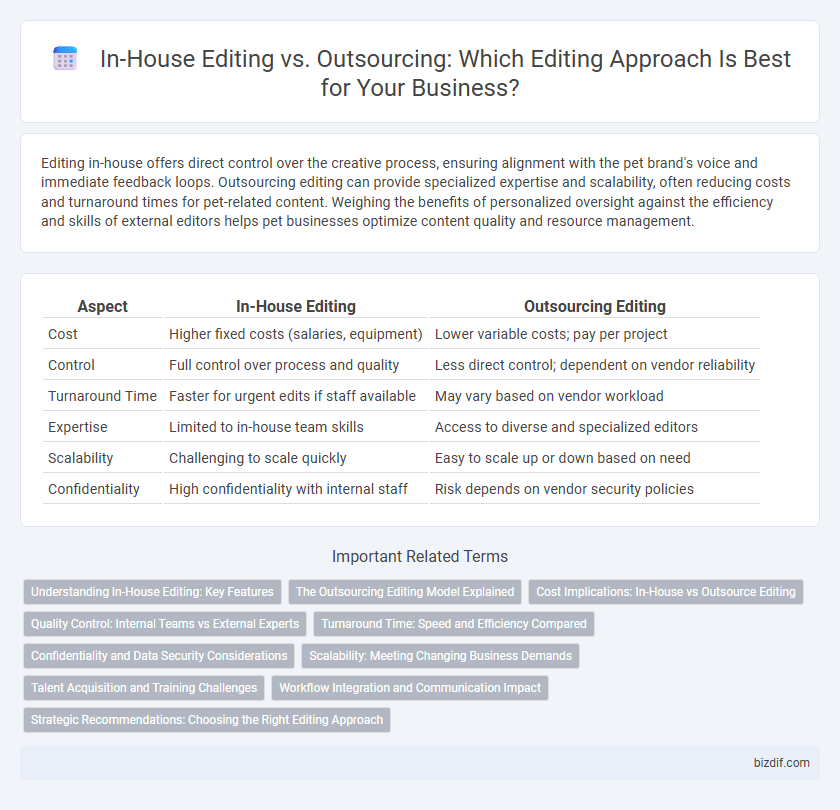Editing in-house offers direct control over the creative process, ensuring alignment with the pet brand's voice and immediate feedback loops. Outsourcing editing can provide specialized expertise and scalability, often reducing costs and turnaround times for pet-related content. Weighing the benefits of personalized oversight against the efficiency and skills of external editors helps pet businesses optimize content quality and resource management.
Table of Comparison
| Aspect | In-House Editing | Outsourcing Editing |
|---|---|---|
| Cost | Higher fixed costs (salaries, equipment) | Lower variable costs; pay per project |
| Control | Full control over process and quality | Less direct control; dependent on vendor reliability |
| Turnaround Time | Faster for urgent edits if staff available | May vary based on vendor workload |
| Expertise | Limited to in-house team skills | Access to diverse and specialized editors |
| Scalability | Challenging to scale quickly | Easy to scale up or down based on need |
| Confidentiality | High confidentiality with internal staff | Risk depends on vendor security policies |
Understanding In-House Editing: Key Features
In-house editing offers direct control over the editorial process, facilitating seamless team collaboration and immediate feedback, which improves content quality and consistency. It leverages internal expertise closely aligned with company goals, ensuring brand voice and style remain uniform across all materials. This approach generally requires dedicated resources, such as skilled editors and appropriate editing software, to maintain efficiency and meet project deadlines.
The Outsourcing Editing Model Explained
The outsourcing editing model involves hiring external professionals or agencies to handle editing tasks, providing flexibility and access to specialized expertise without the overhead costs of in-house staff. This approach allows companies to scale editing resources according to project demands, often resulting in faster turnaround times and improved quality through experienced editors familiar with diverse content types. Outsourcing editing also minimizes the need for internal infrastructure and software investments, enabling businesses to focus resources on core activities while maintaining high editorial standards.
Cost Implications: In-House vs Outsource Editing
In-house editing involves fixed expenses such as salaries, benefits, software licenses, and equipment, which can lead to higher overhead costs compared to outsourcing. Outsourcing editing services often provides a flexible pricing structure based on project scope, reducing the need for long-term financial commitments. Careful analysis of workload volume and budget constraints helps determine whether in-house or outsourced editing offers a more cost-effective solution.
Quality Control: Internal Teams vs External Experts
Internal editing teams ensure consistent quality control through direct alignment with company standards and immediate feedback loops, enabling faster revisions and cohesive style adherence. External experts bring specialized skills and unbiased perspectives that can enhance the quality by catching errors or inconsistencies internal teams might overlook. Balancing in-house familiarity with outsourced expertise often results in the highest quality editorial outcomes.
Turnaround Time: Speed and Efficiency Compared
In-house editing often provides faster turnaround times due to immediate access to editors and streamlined communication within the organization, minimizing delays common in external coordination. Outsourcing editing can introduce longer lead times because of scheduling and transmission of materials, though some specialized firms offer expedited services for urgent projects. Efficiency in turnaround heavily depends on the complexity of the content and the availability of skilled editors, with in-house teams benefiting from institutional knowledge and outsourced editors leveraging broader expertise.
Confidentiality and Data Security Considerations
Choosing in-house editing ensures greater control over confidentiality and data security by limiting access to sensitive materials within a trusted team, reducing the risk of information breaches. Outsourcing editing requires rigorous vetting of external vendors, including non-disclosure agreements (NDAs), secure file transfer protocols, and compliance with industry data protection standards to safeguard proprietary content. Both approaches demand strict security measures, but in-house editing naturally offers tighter oversight of confidential information handling processes.
Scalability: Meeting Changing Business Demands
In-house editing teams provide direct control and faster response times but may struggle to scale quickly with fluctuating workloads. Outsourcing editing services offers flexible scalability, allowing businesses to adjust editing capacity based on project volume without the overhead of maintaining permanent staff. Leveraging outsourcing enables companies to efficiently meet changing business demands while optimizing resource allocation and cost-effectiveness.
Talent Acquisition and Training Challenges
Editing in-house requires significant investment in recruiting skilled editors and providing ongoing training to maintain quality and adapt to evolving style guidelines. Outsourcing editing can mitigate talent acquisition challenges by leveraging specialized agencies with established expertise, though it may limit direct control over training and quality consistency. Balancing these factors is crucial to ensure efficient workflows and high editorial standards.
Workflow Integration and Communication Impact
In-house editing ensures seamless workflow integration due to direct access to project files and immediate feedback loops, enhancing communication efficiency and consistency. Outsourcing editing can introduce delays and miscommunication risks but may offer specialized expertise and scalability when managed with robust project management tools. Effective communication strategies and clear workflow protocols are critical to optimizing the balance between internal control and external collaboration.
Strategic Recommendations: Choosing the Right Editing Approach
Evaluating the cost-effectiveness and quality control of in-house editing versus outsourcing helps determine the ideal approach for a project. Companies prioritizing tight integration and consistent style benefit from in-house resources, while outsourcing offers scalability and access to specialized expertise. Strategic decisions should consider budget constraints, project timelines, and the required level of editorial finesse to optimize content quality and operational efficiency.
Editing In-House vs Outsourcing Editing Infographic

 bizdif.com
bizdif.com